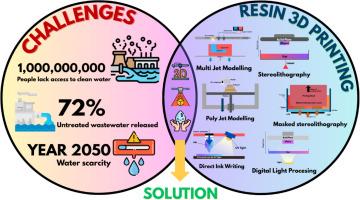开创性的清洁水解决方案:基于树脂的尖端3D打印如何推动可持续修复
IF 9.2
2区 工程技术
Q1 ENERGY & FUELS
引用次数: 0
摘要
水体中污染物的增加,加上工业用水需求的增长,加速了水资源短缺,预计到2050年将进一步恶化。增材制造(AM)最近成为水和废水处理的一种有前途的创新解决方案。本综述探讨了各种增材制造技术,利用液体树脂专门用于制造旨在处理水和废水的产品。从Scopus和谷歌Scholar数据库中检索到各种研究,时间范围从2014年到2025年。采用系统评价和荟萃分析首选报告项目(PRISMA)选择研究;在552项研究中,223项研究被充分审查并用于本研究,所选研究是根据其与废水处理,树脂基AM的相关性以及如何利用它来修复水污染物来确定的。它还强调了3d打印树脂基功能材料的最新进展,用于去除污染物,包括染料,重金属,油和药物。此外,还讨论了这些3d打印结构与其他化合物的集成,以增强其功能。虽然3d打印树脂基结构显示出显著的多功能性和有效性,但由于各种技术和环境挑战,AM在废水处理中的应用与其他领域相比滞后。关键问题包括有毒树脂成分的潜在浸出到环境中以及基于am的处理系统的可扩展性。尽管存在这些问题,定制化和功能化树脂材料的能力为创建适合污染物修复的多功能结构提供了有希望的途径。这篇综述不仅强调了基于树脂的增材制造的优势,特别是在实现耐用和适应性设计方面,而且还强调了必须解决的紧迫挑战。对这些因素的平衡理解对于优化基于树脂的增材制造技术并加速其与可持续水和废水处理解决方案的整合至关重要。本文章由计算机程序翻译,如有差异,请以英文原文为准。

Pioneering clean water solutions: How cutting-edge resin-based 3D printing is driving sustainable remediation
The increasing presence of pollutants in water bodies, coupled with growing industrial water demand, has accelerated water scarcity, which is projected to worsen by 2050. Additive manufacturing (AM) has recently emerged as a promising and innovative solution for water and wastewater treatment. This review explores various AM techniques that utilize liquid resin specifically for fabricating products aimed at treating water and wastewater. Various research studies were retrieved from Scopus and Google Scholar databases, with a time range from 2014 to 2025. Preferred Reporting Items for Systematic Reviews and Meta-Analyses (PRISMA) was adopted for selecting the studies; out of 552 studies, 223 were fully examined and used in this study, and the selected studies were determined based on its relevancy to wastewater treatments, resin-based AM, and how it is being utilized to remediate water pollutants. It also highlights recent advancements in 3D-printable resin-based functional materials for removing pollutants, including dyes, heavy metals, oil, and pharmaceuticals. Additionally, the integration of these 3D-printed structures with other chemical compounds to enhance their functionalities is discussed. While 3D-printed resin-based structures demonstrate significant versatility and effectiveness, the adoption of AM in wastewater treatment has lagged compared to other sectors due to various technical and environmental challenges. Key concerns include the potential leaching of toxic resin components into the environment and the scalability of AM-based treatment systems. Despite these issues, the ability to customise and functionalize resin materials offers promising avenues for creating multifunctional structures tailored for pollutant remediation. This review highlights not only the strengths of resin-based AM, particularly in enabling durable and adaptable designs, but also the pressing challenges that must be addressed. A balanced understanding of these factors is essential for optimizing resin-based AM techniques and accelerating their integration into sustainable water and wastewater treatment solutions.
求助全文
通过发布文献求助,成功后即可免费获取论文全文。
去求助
来源期刊

Sustainable Materials and Technologies
Energy-Renewable Energy, Sustainability and the Environment
CiteScore
13.40
自引率
4.20%
发文量
158
审稿时长
45 days
期刊介绍:
Sustainable Materials and Technologies (SM&T), an international, cross-disciplinary, fully open access journal published by Elsevier, focuses on original full-length research articles and reviews. It covers applied or fundamental science of nano-, micro-, meso-, and macro-scale aspects of materials and technologies for sustainable development. SM&T gives special attention to contributions that bridge the knowledge gap between materials and system designs.
 求助内容:
求助内容: 应助结果提醒方式:
应助结果提醒方式:


